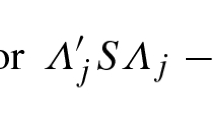Abstract
This paper describes a method of matrix decomposition which retains the ability of factor analytic techniques to summarize data in terms of a relatively low number of coordinates; but at the same time, does not sacrifice the useful analysis of variance heuristic of partitioning data matrices into independent sources of variation which are relatively simple to interpret. The basic model is essentially a two-way analysis of variance model which requires that the matrix of interaction parameters be decomposed by using factor analytic techniques. Problems of judging statistical significance are discussed; and an illustrative example is presented.
Similar content being viewed by others
References
Abelson, R. P. Computer simulation of “hot” cognition. In S. S. Tomkins, & S. Messick (Eds.),Computer simulation of personality. New York: Wiley, 1963, 277–298.
Burt, C. Correlations between persons.British Journal of Psychology, 1937,28, 59–95.
Burt, C. A comparison of factor analysis and analysis of variance.British Journal of Psychology, Statistical Section, 1947,1, 3–26.
Burt, C. The appropriate uses of factor analysis and analysis of variance. In R. B. Cattell (Ed.),Handbook of multivariate experimental psychology. Chicago: Rand McNally, 1966, 267–287.
Creasy, Monica A. Analysis of variance as an alternative to factor analysis.Journal of the Royal Statistical Society, Series B, 1957,19, 318–325.
Eckart, C., & Young, G. The approximation of one matrix by another of lower rank.Psychometrika, 1936,1, 211–218.
Gollob, H. F.A combined additive and multiplicative model of word combination in sentences. Unpublished Ph.D. dissertation, Yale University, 1965.
Green, B. F., & Tukey, J. W. Complex analyses of variance: General problems.Psychometrika, 1960,25, 127–152.
Harman, H. H.Modern factor analysis. Chicago: Univ. Chicago Press, 1960.
Hays, W. L.Statistics for psychologists. New York: Holt, 1963.
Heider, F. On social cognition.American Psychologist, 1967,22, 25–31.
Horst, P.Matrix algebra for social scientists. New York: Holt, 1963.
Mandel, J. Non-additivity in two-way analysis of variance.Journal of the American Statistical Association 1961,56, 878–888.
Scheffé, H. A.The analysis of variance. New York: Wiley, 1959.
Snedecor, G. W.Statistical methods applied to experiments in agriculture and biology, 5th edition. Ames, Iowa: Iowa State College Press, 1956.
Tukey, J. W. One degree of freedom for nonadditivity.Biometrics, 1949,5, 232–242.
Tukey, J. W. The future of data analysis.Annals of Mathematical Statistics, 1962,33, 1–67.
Winer, B. J.Statistical principles in experimental design. New York: McGraw, 1962.
Author information
Authors and Affiliations
Additional information
Much of the work on this paper was completed while the author held a U.S.P.H.S. Postdoctoral Fellowship at Yale University (1964–65). Many of the ideas in this paper have been discussed in the author's doctoral dissertation which was submitted to Yale University in 1965.
Special thanks are due to Robert P. Abelson for his encouragement and for many helpful and stimulating discussions about problems which arose in the preparation of this paper. I would also like to thank Francis J. Anscombe and Alan T. James for their valuable suggestions and constructive criticism of an earlier draft of this article.
Rights and permissions
About this article
Cite this article
Gollob, H.F. A statistical model which combines features of factor analytic and analysis of variance techniques. Psychometrika 33, 73–115 (1968). https://doi.org/10.1007/BF02289676
Received:
Revised:
Issue Date:
DOI: https://doi.org/10.1007/BF02289676




